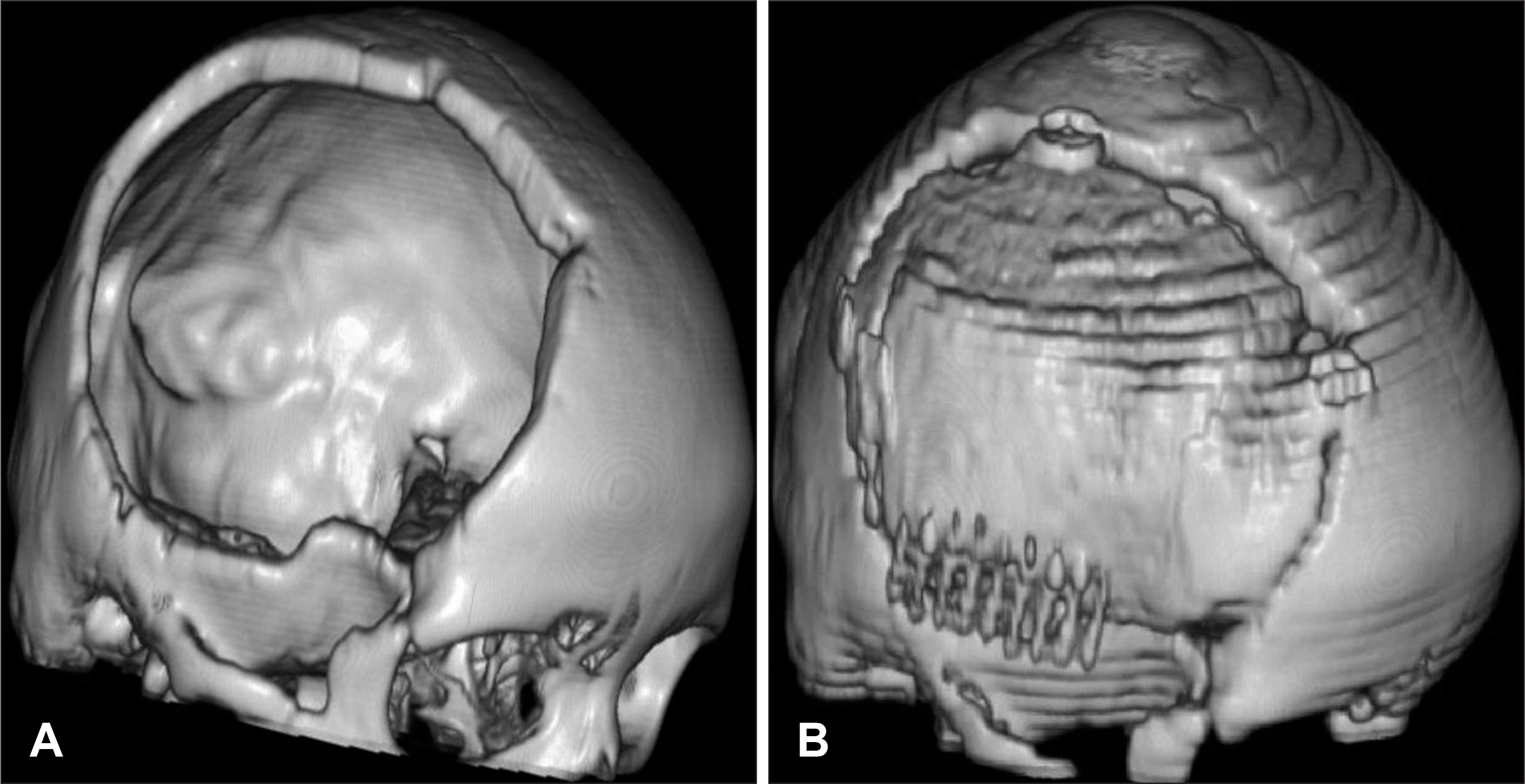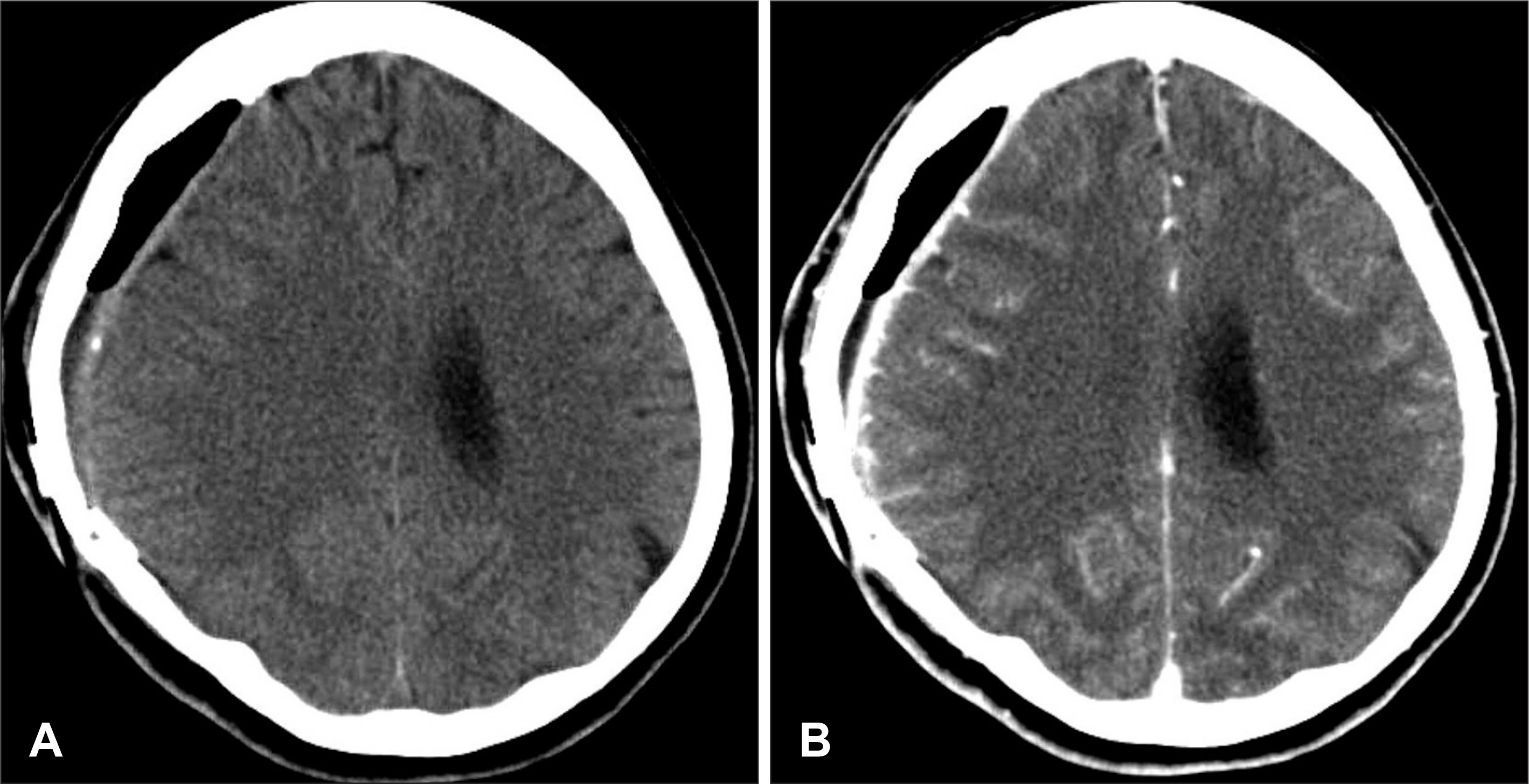Korean J Neurotrauma.
2012 Apr;8(1):21-25. 10.13004/kjnt.2012.8.1.21.
Comparison with Subcutaneous Abdominal Preservation and Cryoconservation Using Autologous Bone Flap after Decompressive Craniectomy
- Affiliations
-
- 1Department of Neurosurgery, Chungbuk National University Hospital, Chungbuk National University College of Medicine, Cheongju, Korea. dhkim@chungbuk.ac.kr
- KMID: 1427678
- DOI: http://doi.org/10.13004/kjnt.2012.8.1.21
Abstract
OBJECTIVE
After decompressive craniectomy was performed in patients with severe brain swelling, we were able to preserve autologous bone flap as freeze-preserved state or within abdominal subcutaneous tissue. The aim of this study was to compare the freeze-preservation with the subcutaneous abdominal preservation regarding the effectiveness and safety.
METHODS
The clinical data of 53 patients who underwent decompressive craniectomy with autologous bone flap cranioplasty in our department were studied retrospectively. 43 patients underwent cranial reconstruction using autologous bone flap stored in deep freezer. In 10 patients cranioplasty was performed to repair bone defect using autologous bone flap preserved in subcutaneous abdomen. The analysis included the rates of infection, bone absorption and other complications and operation time to compare these two methods.
RESULTS
Cranioplasty using deep-freezing bone flap showed a low infection rate (2.3%), low bone absorption (2.3%) and no cosmetic problem. The average time of operation is 146 minutes. Cranioplasty using a bone flap banked in the patient's abdominal wall revealed no case of complications. The average time of operation is 130 minutes. The longer period the bone flap was preserved for, the longer time the operation took in both methods.
CONCLUSION
This study may be worth considering that both methods of cryoconservation and subcutaneous abdominal preservetion are feasible for the repair of skull defect although abdominal preservation seems to show better result a little. If the deep-freezer is not available, a bone flap banked in the patient's abdominal wall can be used.
MeSH Terms
Figure
Cited by 3 articles
-
Resorption of Autogenous Bone Graft in Cranioplasty: Resorption and Reintegration Failure
Si Hoon Lee, Chan Jong Yoo, Uhn Lee, Cheol Wan Park, Sang Gu Lee, Woo Kyung Kim
Korean J Neurotrauma. 2014;10(1):10-14. doi: 10.13004/kjnt.2014.10.1.10.Review of Cranioplasty after Decompressive Craniectomy
Yong Jun Cho, Suk Hyung Kang
Korean J Neurotrauma. 2017;13(1):9-14. doi: 10.13004/kjnt.2017.13.1.9.The Current Analysis of the Risk Factors for Bone Graft Infection after Cranioplasty
Sang-Mi Yang, Hyung-Ki Park, Sung-Jin Cho, Jae-Chil Chang, Sukh-Que Park, Ra-Sun Kim
Korean J Neurotrauma. 2013;9(2):57-63. doi: 10.13004/kjnt.2013.9.2.57.
Reference
-
1). Aarabi B., Hesdorffer DC., Ahn ES., Aresco C., Scalea TM., Eisenberg HM. Outcome following decompressive craniectomy for malignant swelling due to severe head injury. J Neurosurg. 104:469–479. 2006.
Article2). Baldo S., Tacconi L. Effectiveness and safety of subcutaneous abdominal preservation of autologous bone flap after decompressive craniectomy: a prospective pilot study. World Neurosurg. 73:552–556. 2010.
Article3). Bhaskar IP., Zaw NN., Zheng M., Lee GY. Bone flap storage following craniectomy: a survey of practices in major Australian neurosurgical centres. ANZ J Surg. 81:137–141. 2011.
Article4). Bok WK., Hong SK., Min KS., Lee MS., Kim YG., Kim DH. Cranioplasty Using Frozen Autologous Bone. J Korean Neurosurg Soc. 33:166–169. 2003.5). Bullock MR., Chesnut R., Ghajar J., Gordon D., Hartl R., Newell DW, et al. Surgical management of traumatic parenchymal lesions. Neurosurgery 58: S25-S46; discussion Si-iv. 2006.
Article6). Dujovny M., Aviles A., Agner C., Fernandez P., Charbel FT. Cranioplasty: cosmetic or therapeutic? Surg Neurol. 47:238–241. 1997.
Article7). Greitz D. Cerebrospinal fluid circulation and associated intracranial dynamics. A radiologic investigation using MR imaging and radionuclide cisternography. Acta Radiol Suppl. 386:1–23. 1993.8). Inclan A. The use of preserved bone grafts in orthopaedic surgery. J Bone Joint Surg. 24:81–96. 1942.9). Kim YW., Yoo DS., Kim DS., Huh PW., Cho KS., Kim JG, et al. The infection rate in case of cranioplasty according to used materials and skull defect duration. J Korean Neurosurg Soc. 30:216–220. 2001.10). Koizumi H., Fukamachi A., Nukui H. Postoperative subdural fluid collections in neurosurgery. Surg Neurol. 27:147–153. 1987.
Article11). Mazur P. Freezing of living cells: mechanisms and implications. Am J Physiol 247: C125-C142. 1984.
Article12). Miyazaki T., Hirase Y. Experimental study of cryopreserved allogenic ear cartilage transplantation. Long-term storage and transfer of rabbit ear cartilage. J Jpn Plast Reconstr Surg. 17:6–16. 1997.13). Naffziger HC. Subdural fluid accumulations following head injury. JAMA. 82:1751–1752. 1924.
Article14). Osawa M., Hara H., Ichinose Y., Koyama T., Kobayashi S., Sugita Y. Cranioplasty with a frozen and autoclaved bone flap. Acta Neu-rochir (Wien). 102:38–41. 1990.
Article15). Prolo DJ., Burres KP., McLaughlin WT., Christensen AH. Autogenous skull cranioplasty: fresh and preserved (frozen), with consideration of the cellular response. Neurosurgery. 4:18–29. 1979.16). Tabaddor K., LaMorgese J. Complication of a large cranial defect. Case report. J Neurosurg. 44:506–508. 1976.17). Winkler PA., Stummer W., Linke R., Krishnan KG., Tatsch K. Influence of cranioplasty on postural blood flow regulation, cerebrovascular reserve capacity, and cerebral glucose metabolism. J Neurosurg. 93:53–61. 2000.
Article
- Full Text Links
- Actions
-
Cited
- CITED
-
- Close
- Share
- Similar articles
-
- Availabilities of Cranioplasty with Autologous Bone Flap Preserved within Abdominal Subcutaneous Tissue after Decompressive Craniectomy
- Analysis of Cranioplasty Using Frozen Autologous Bone Following Post-Traumatic Decompressive Craniectomy
- Bone Resorption of Autologous Cranioplasty Following Decompressive Craniectomy in Children: Case Report
- Resorption of Autogenous Bone Graft in Cranioplasty: Resorption and Reintegration Failure
- Delayed and recurrent surgical site infection from resorbed bone fragment after autologous cranioplasty: a case report




